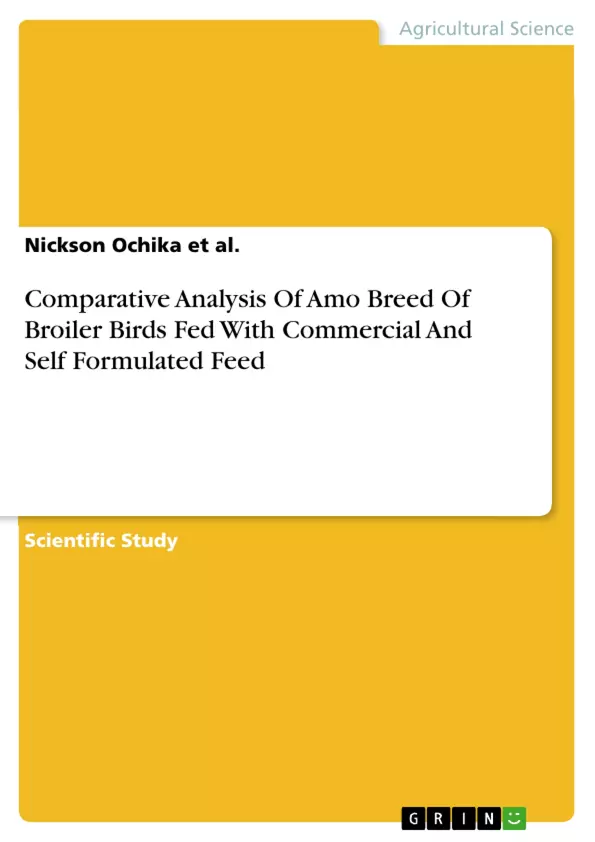This study is aimed at comparing the effect of commercial and formulated feed on Amo breed of broilers. A comparative analysis of commercial and formulated feed on Amo breed of broiler was carried out.
The term “poultry” used in agriculture generally refers to all domesticated birds kept for eggs or meat production. These include chickens, (domesticated fowl) turkey, ducks, geese, pigeons, guinea fowl and other birds.
The most common of all these in Nigeria is the domestic fowl. Sometime the term “poultry” is considered synonymous with chickens (Igbokwe 2010).
The term poultry is a broad classification covering the species of all domesticated birds that are raised primarily for the production of meat and eggs for human consumption. The term applies to chickens, turkeys, ducks, swans, geese, guinea fowl and other birds.
However, among all these food producing birds, chickens are probably more than all the other birds and found throughout the world, (Feetham 1990).
Poultry production is one of the most important agricultural business practiced in Nigeria. But one of the challenges posed on the production of poultry is that the feed are mostly derived from crops such as maize, sorghum, and other grain crops. As a consequence, feed ingredients need to be acquired from distant supply area and may not be hundred percent (100%) sufficient in nutrients content and also very expensive (Nyoupayou 1990).
Researches have been undertaken since the 1930s on ways to improve feeds efficiency in broiler birds’ production. Comparative trials have been conducted on the use of commercially formulated feeds and the locally produced ones to find out the most efficient form of feed that yields high growth rate and reduce production costs. (Mc Donald, 1987).
Table of Contents
- Chapter One
- Introduction
- Statement of the problem
- Purpose of the Study
- Objective of the study
- Significance of the study
- Research Question
- Limitation of the study
- Chapter Two
- Introduction
- Live weight gain of birds as per the two type of feed used
- Breed of broiler
- White hybrids
- Colored hybrids
- Heritage poultry breeds
- Feeding and feed conversion
- Housing of Broiler
- Handling and Transport of Broilers
- Definition Of The Terms
- Chapter Three
- Research Methodology
- Description of the research work area
- Sampling size and Sampling Techniques
- Analytical tool and method of data analysis
Objectives and Key Themes
This research aims to evaluate the impact of different feed types, commercial and formulated, on the growth and development of Amo breed broilers. The study seeks to determine if there are significant differences in growth parameters and feed conversion efficiency between the two feeding regimes.
- Comparative analysis of commercial and formulated feed on Amo breed broilers.
- Evaluating the effects of different feed types on broiler growth performance.
- Assessing feed conversion efficiency in relation to the type of feed used.
- Investigating the impact of feeding practices on the overall health and well-being of broilers.
Chapter Summaries
Chapter One provides an introduction to the study, outlining the problem statement, the purpose and objectives of the research, and the significance of the study. It also defines the research question, identifies limitations, and briefly discusses the methodology used.
Chapter Two delves into the relevant literature, reviewing previous studies and research findings related to broiler feed, breed types, feeding practices, and housing conditions. It also examines the concept of live weight gain, feed conversion efficiency, and the handling and transportation of broilers.
Keywords
The study focuses on the comparative analysis of commercial and formulated feed for Amo breed broilers, with emphasis on growth performance, feed conversion efficiency, and the impact of feeding practices on broiler health and well-being. This research utilizes empirical data to analyze the differences in growth parameters and feed conversion efficiency between the two feeding regimes.
- Citation du texte
- Nickson Ochika et al. (Auteur), 2015, Comparative Analysis Of Amo Breed Of Broiler Birds Fed With Commercial And Self Formulated Feed, Munich, GRIN Verlag, https://www.grin.com/document/315132



